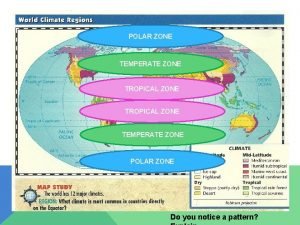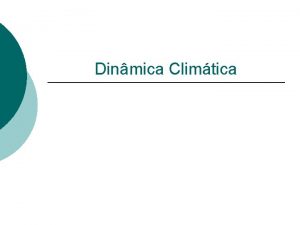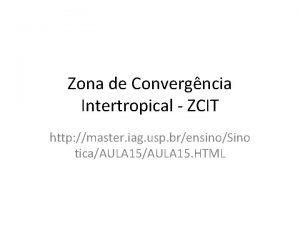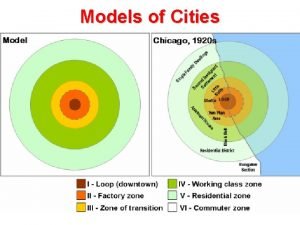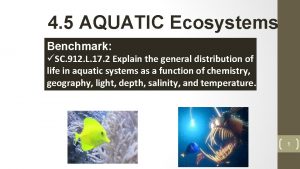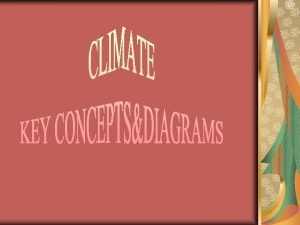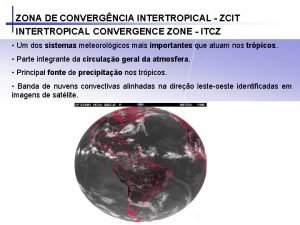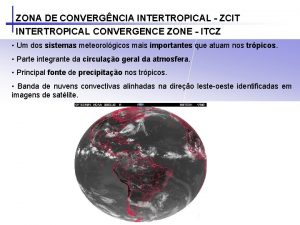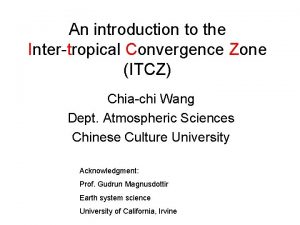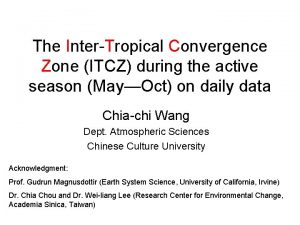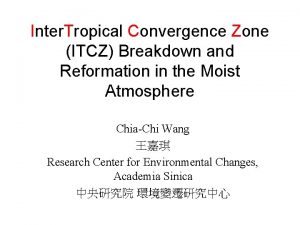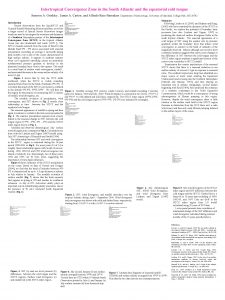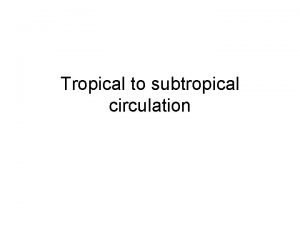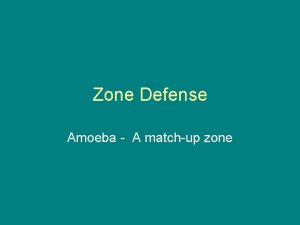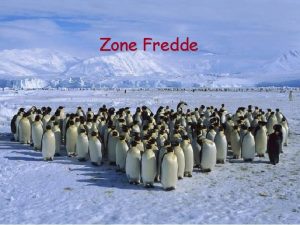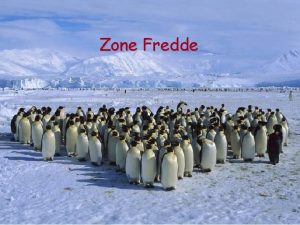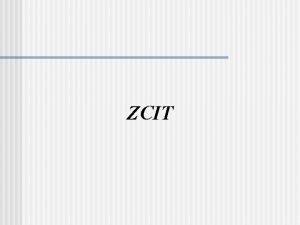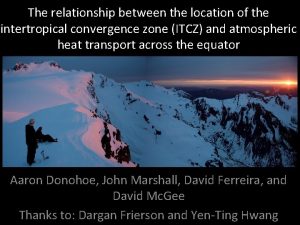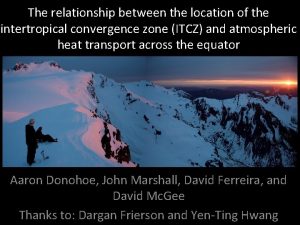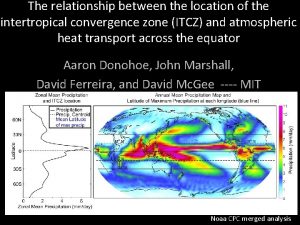Intertropical Convergence Zone ITCZ What is the Inter






























- Slides: 30

Intertropical Convergence Zone (ITCZ)

What is the Inter Tropical Convergence Zone? • A belt of low pressure produced by heating at the equator and the convergence of the trade winds (tropical continental (over land = dry) and tropical maritime (over sea = wet)). • This zone moves in response to the changing position of thermal equator (the area receiving the most intense heat).

Diagrams Task • Can you give your blank Africa maps the following titles: 1. Thermal Equator Positions 2. ITCZ in January 3. ITCZ in July 4. Tropical Airmasses





Thermal Equator • The thermal equator receives the most intense heat from the Sun. Around 20 th June each year the Sun is overhead at 23½º North, the Tropic of Cancer. Around 20 th December the Sun is overhead at 23½º South, the Tropic of Capricorn.


The ITCZ in Africa • The Seasonal change in the location of the ITCZ governs the supply of rainfall in locations throughout Africa. • The ITCZ in Africa moves with the Thermal Equator – you need to know key features for January and July. • Weather associated with ITCZ = heavy precipitation/high intensity rainfall. • Copy Figure 2. 22 from Textbook Page 21 – remember the key and make lines nice and clear.

• Copy Figure 2. 22 and 2. 23 from Textbook Page 21 – remember the key and make lines nice and clear. • Copy Figure 2. 23 – Page 22.


ITCZ in Africa • Weather associated with ITCZ = heavy precipitation/high intensity rainfall. • Key Rules • ITCZ = band of low pressure where trade winds meet. • Directly underneath ITCZ = thunderstorms, heavy rain (two air masses are meeting – pushing maritime air up, cools and condenses to form clouds. ) • South of ITCZ = wet weather due to Tropical Maritime air mass. • North of ITCZ = dry weather due to Tropical Continental air mass.

ITCZ in July • • Northern Hemisphere Summer Time. ITCZ moves to Tropic of Cancer. Sahara receiving maximum insolation. Low air pressure of ITCZ pulls in hot, moist, tropical maritime winds (such as south westerlies from Atlantic source close to West and Central Africa). • Moisture from Tropical maritime winds therefore brings wet season to West Africa.

ITCZ in January • Thermal equator changes – ITCZ moves with it to the Tropic of Capricorn (southern hemisphere summer). Some still found about 8 o. N along coastal belt of West Africa. • Most of Africa north of equator experiences dry season (bar East Africa and coastal belt of West Africa). • Due to influence of Tropical Continental air = hot, dry air. • Hot, dry north-east wind which brings large amounts of dust is called the Harmattan.

The Two Air Masses Tropical Continental (travelled over land (continent)) = dry. Tropical Maritime (travelled over sea (maritime)) = wet Copy Figure 2. 23 (page 22)

– r e h t e g o t l l a t i t u p Now d n a Z C T I e h t s e o d How r i a d e t a i c its asso e h t e c n e u l f n i s e s s ma ? a c i r f A f o climate

* How does the ITCZ and its associated air masses influence the climate of Africa? The ITCZ shifts position throughout the year in relation to the apparent movement of the sun because of the way the earth sits on its axis. In July The sun is directly overhead the Tropic of Cancer due to the tilt of the earth. The ITCZ migrates northwards and is positioned over the Tropic of Cancer. Tr op ic E qu of Tr op at Ca ic or nc of er Ca pr ico rn ITCZ is positioned at the Tropic of Cancer 23 ½ºN 0º 23½ºS

This means that Africa is dominated by the Tropical Maritime air mass, bringing with it warm, wet and generally unstable conditions. This explains why July is Africa’s wet season. c. T ITCZ m. T ITCZ positioned at Tropic of Cancer Warm moist unstable Tropical Maritime Air dominates most of Africa.

In January The sun is directly overhead the Tropic of Capricorn due to the tilt of the earth. Therefore the ITCZ migrates south and is positioned over the Tropic of Capricorn. er nc Ca f or icorn o c pi uat Capr o r T q of E Tro pic ITCZ 23 ½ºN 0º 23½ºS ITCZ is positioned at the Tropic of Capricorn

This means that much of Africa is influenced by Tropical Continental air, bringing with it warm, dry stable conditions and the warm, drying Harmattan wind. This explains why most of Africa experiences its dry season at this time of year. ITCZ m. T c. T Warm, dry stable Tropical Continental Air dominates most of Africa. ITCZ positioned at Tropic of Capricon Some western and southern parts of Africa remain under the influence of Tropical Maritime air because the Tropical Continental air mass (above the ITCZ) is not strong enough to push against the dense Tropical Maritime air mass which is moving into the land from the sea.

Lets do it on a larger scale!

Use your notes on the ITCZ to answer the following questions: 1) 2) 3) 4) 5) 6) 7) 8) 9) 10) Write a definition for the ITCZ. What type of air pressure occurs at the ITCZ? What weather does the tropical continental air mass bring? What weather doe the tropical maritime air mass bring? What will the weather be like at the ITCZ? Why does the ITCZ appear to migrate to different positions throughout the year? Where is the ITCZ positioned in a) July b) January Explain why most of Africa experiences warm, wet weather in July. Explain why most of Africa experiences its dry season in January. Why do some parts of western and southern Africa always experience Tropical Maritime air?

* Explain the varying rainfall patterns shown in Reference Diagram Q 1 B. (8) Take each climate graph and explain the patterns of rainfall. Look at the average rainfall data. What patterns can you see? Which area has most / least rainfall on average?

* Explain the varying rainfall patterns shown in Reference Diagram Q 1 B. (8) Take each climate graph and explain the patterns of rainfall. Look at the average rainfall data. What patterns can you see? Which area has most / least rainfall on average?

* Explain the varying rainfall patterns shown in Reference Diagram Q 1 B. (8) Take each climate graph and explain the patterns of rainfall. Look at the average rainfall data. What patterns can you see? Which area has most / least rainfall on average?

* Explain the varying rainfall patterns shown in Reference Diagram Q 1 B. (8) Take each climate graph and explain the patterns of rainfall. Look at the average rainfall data. What patterns can you see? Which area has most / least rainfall on average?

* What do the graphs show? Timbukto has on average very little rainfall (only 250 mm per annum). It has no rainfall at all in January, February November and December. Jos too has distinct wet and dry seasons, experiencing 1000 mm of rainfall per annum, a peak of 300 mm in July and minimal rainfall in November, December, January and February. In contrast, Lagos has markedly more rainfall throughout the year, with up to 2000 mm per annum, and rainfall peaking twice in the year. (June at 475 mm and October at 200 mm). It also has no dry months at all. * Now for the explanations! Questions to ask yourself: 1) why do Timbukto and Jos experience rainfall in July? 2) Why do Timbukto and Jos experience no rainfall at all in November, December, January and February? 3) Why does Lagos experience more rainfall on average, and gets rainfall throughout the year? 4) What is responsible for the twin rainfall peaks in Lagos in June and October?

* Check your explanations These patterns can be attributed to the movement of the ITCZ and its associated air masses. Lagos is under the influence of warm moist Tropical Maritime air for most of the year, which explains its higher annual rainfall amounts and lack of dry season. Its twin rainfall peaks are caused by the ITCZ migrating northwards and southwards in relation to the position of the sun. Timbukto and Jos in contrast are much further North than the ITCZ in January, which is positioned at the Tropic of Capricorn. This will result in Timbukto and Jos being influenced by warm, dry Tropical Continental air, which explains why they have either no or very little rainfall during these months. In June and July Timbukto experiences its highest rainfall amounts because the ITCZ has migrated northwards due to the position of the sun overhead the Tropic of Cancer. This results in Timbukto experiencing Tropical Maritime air at these times, hence this is when it gets the majority of rainfall. Similarly, this is why Jos experiences its highest rainfall totals (300 mm and 275 mm respectively) in July and August.

Attempt on your own… • 2016 Past Paper • New Higher Specimen Paper
 Why is it called horse latitudes
Why is it called horse latitudes Neritic zone climate
Neritic zone climate Source zone transition zone and floodplain zone
Source zone transition zone and floodplain zone Temperate regions countries
Temperate regions countries Latitude
Latitude Convergência intertropical
Convergência intertropical Iag master
Iag master Clima tropical
Clima tropical Zona equatorial
Zona equatorial Absolute convergence definition
Absolute convergence definition Zone de convergence
Zone de convergence Zone froide rayon
Zone froide rayon Conducting zone vs respiratory zone
Conducting zone vs respiratory zone Underground water table
Underground water table Water table chart
Water table chart Zone 1 and zone 2
Zone 1 and zone 2 Spirogram diagram
Spirogram diagram Freshwater biome latitude and longitude
Freshwater biome latitude and longitude Concentric zone model
Concentric zone model Conducting zone of the respiratory system function
Conducting zone of the respiratory system function Photic zone and aphotic zone venn diagram
Photic zone and aphotic zone venn diagram Quá trình desamine hóa có thể tạo ra
Quá trình desamine hóa có thể tạo ra Các môn thể thao bắt đầu bằng tiếng nhảy
Các môn thể thao bắt đầu bằng tiếng nhảy Công thức tính thế năng
Công thức tính thế năng Thế nào là mạng điện lắp đặt kiểu nổi
Thế nào là mạng điện lắp đặt kiểu nổi Hát kết hợp bộ gõ cơ thể
Hát kết hợp bộ gõ cơ thể Khi nào hổ mẹ dạy hổ con săn mồi
Khi nào hổ mẹ dạy hổ con săn mồi Dot
Dot Thế nào là sự mỏi cơ
Thế nào là sự mỏi cơ Vẽ hình chiếu đứng bằng cạnh của vật thể
Vẽ hình chiếu đứng bằng cạnh của vật thể Phản ứng thế ankan
Phản ứng thế ankan
